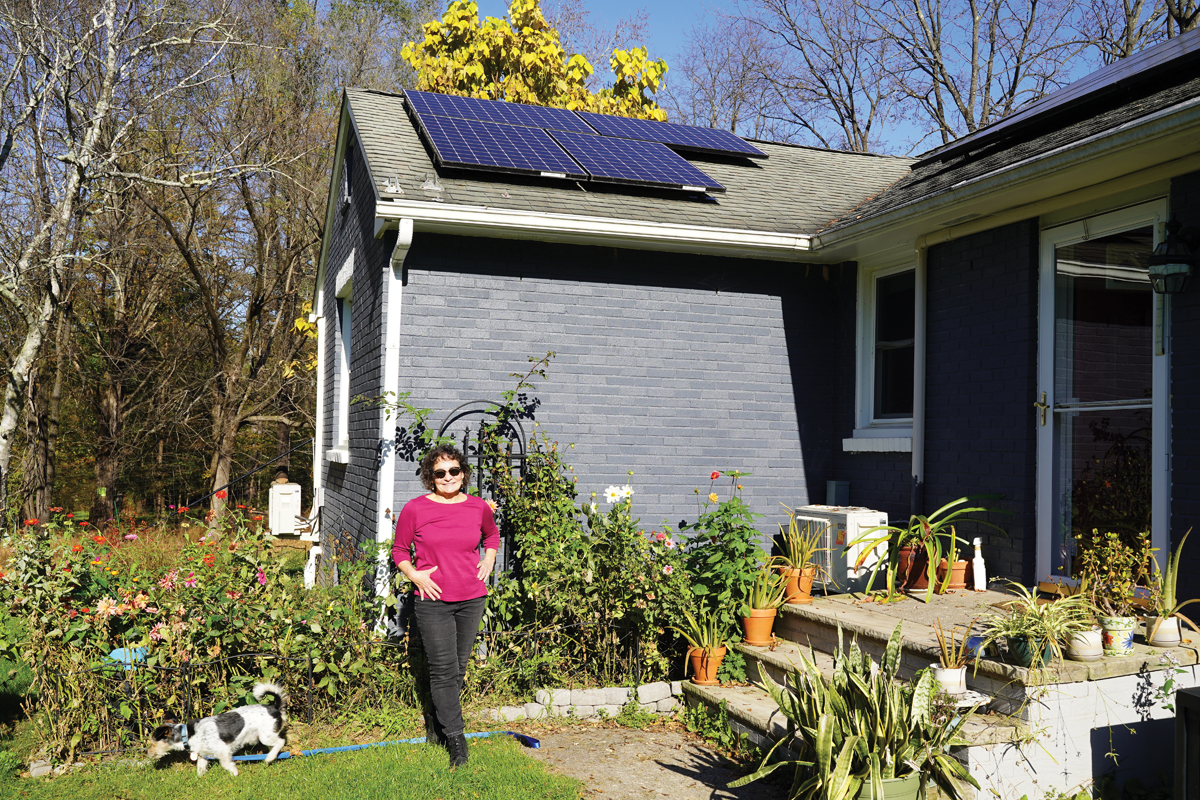The Journey to Electrifying Your House
By Melissa Everett | Winter 2023 | Clean Power Guide
Lisa Giannico is a retired assistant school principal who moved to Stone Ridge in 2021. She bought a 1,700-square-foot ranch house built in the 1960s, turned the basement into an art studio, and followed a thunderous instinct that the whole thing had to be as green as possible. She trained in the Cornell Cooperative Extension Master Gardener Program and joined the town Environmental Conservation Commission, a ready-made fellowship of knowledgeable people who like to get things done. Three years later, Giannico’s house is 100 percent renewably powered, and the lawn transition to pollinator garden is well underway.
It was a steep but enjoyable learning curve. “I was an apartment dweller. I had a big vision but no idea what it would entail,” she says. “By plugging into area nonprofits and local commissions—which anyone can do—I had no idea how much money and support are available. I also learned that I have significantly increased the value of my house.”
Taking the First Step
When Giannico closed on the house and had an inspection, an electrical issue was discovered. Through her realtor, she found an expert contractor who guided her on what needed to be done quickly and what could be put off. Because Giannico let him know her interest in going solar, she was able to have a full upgrade of her electrical service to prepare for electrification (which older homes may need).
Next came a chimney inspection, which uncovered problems with the existing chimney and wood stove, in the middle of the pandemic, leaving her without heat for a time and determined never to have that experience again. Fortunately, the repair contractor made Giannico aware of rebates for high-efficiency woodstoves that recycle much of their emissions, and she was able to purchase one of these sooner than expected. “That, too, is a learning curve—what kind of wood to buy, how to use it efficiently, and how to store it properly,” she notes.

Giannico’s next project, solar panels, were the original driver of her dream. She has a good flat roof, but its orientation is not ideal, so she ended up with more panels than a south-facing home would need. She found a company that offered zero percent financing, which is not hard to do if you look.
The house had a heat pump, but it was placed in a corner where it didn’t do much good, so it was relocated. To keep the cost down, Giannico’s strategy was to install one heat pump at a time, starting in the bedroom, then continuing into the rest of the house. She watched for special deals and zero percent financing here, too.
A kitchen remodel came next, with an induction range, which made good use of those wiring upgrades. Giannico left space for one more heat pump if needed, to make it possible to get rid of the oil burner.
“Next was an independent home energy audit—which I now understand should have come first!” she says. “My original home inspector said casually, ‘You might want to replace that old insulation at some point.’ The energy auditor said, ‘Your insulation is R7 and we can upgrade it to R51 and your house will be cozy.’ From the audit I learned that attic and basement insulation would make a fundamental difference in the sizing of my heating and cooling equipment and my solar panels. I insulated the basement rim joists too, which has made it much more comfortable in the studio and when I’m doing yoga in the living room.”

For every home energy makeover, there is a logical sequence. In Giannico’s case, the attic insulation has had to come after improvements like installing ceiling fans and lighting upgrades, as the insulation restricts access to the attic. “You want to put on those solar panels right away, but in reality, you have to work backwards to make sure your roof and your electrical wiring are ready,” she says. “In hindsight, the audit and insulation should have been done much sooner.” Now, with groundwork done and solar installed, Giannico’s Central Hudson bill is limited to the monthly service charge.
What’s next? A heat pump water heater and a few more solar panels, then a home EV charger, and an EV in due time. Giannico’s lifestyle is hyperlocal, with mostly short drives, so this sequence makes sense for her. Doing one thing at a time, and getting it paid off, has been a low-stress financing strategy.
What were the main surprises? Except for how little the building inspector knew about energy, the lessons were positive. “People do not realize how much money is available, how many different ways to finance these investments,” Gianicco says. “They don’t realize how much support and information is out there. I get this information in my inbox regularly now, but most people do not. That is what we have to change.”
